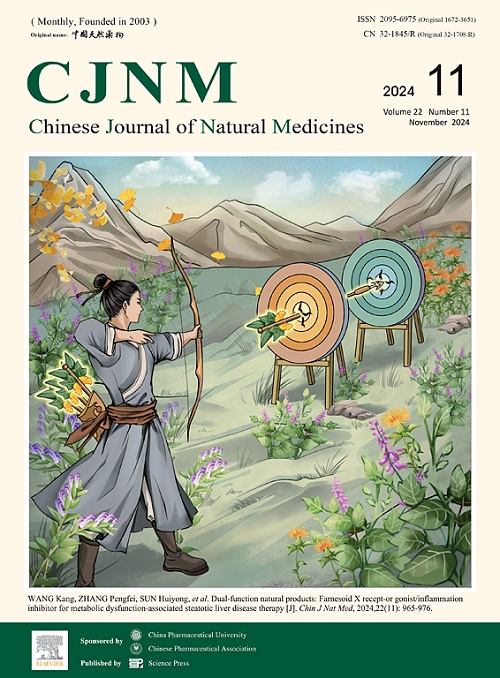真菌Auxarthron umbrinum DSM3193中新的四氢蒽醌类和γ-丁烯内酯类
IF 4.9
2区 医学
Q1 INTEGRATIVE & COMPLEMENTARY MEDICINE
引用次数: 0
摘要
采用一株多化合物(OSMAC)法,从水稻固体培养的umbrinum (A. umbrinum) DSM3193中分离到9个新化合物,包括7个四氢蒽醌(Auxarthron A−G, 1−7)、1个γ-丁烯内酯苷(malfilamentoside E, 26)和1个γ-丁烯内酯(auxarthrolide A, 27),以及18个已知化合物(8−25)。这些化合物的结构通过核磁共振(NMR)、质谱(MS)和核磁共振计算结合DP4+分析或MAEΔΔδ参数进行了解析,而新化合物的绝对构型则通过单晶x射线衍射、电子圆二色(ECD)光谱数据分析和/或化学衍生化来确定。austrocorlutein(10)和auxarthrol H(14)对U87和U251表现出中等的细胞毒性[一半最大抑制浓度(IC50) 3.5 ~ 12.1 μmol·L−1]。此外,auxarthroone A(1)、auxarthrol H(14)、eupolyhagin B(15)和7-羟基-2-(2-羟丙基)-5-甲基色素(17)对油酸诱导的成纤维细胞增殖挑战表现出扭转作用,从而显示出成纤维细胞增殖促进活性。本文章由计算机程序翻译,如有差异,请以英文原文为准。
New tetrahydroanthraquinones and γ-butenolides from the fungus Auxarthron umbrinum DSM3193
Nine novel compounds, comprising seven tetrahydroanthraquinones (auxarthrolones A−G, 1−7), a γ-butenolide glycoside (malfilamentoside E, 26), and a γ-butenolide (auxarthrolide A, 27), together with eighteen known compounds (8−25) were isolated from rice-based solid culture of Auxarthron umbrinum (A. umbrinum) DSM3193 using the one strain many compounds (OSMAC) approach. The structural elucidation of these compounds was accomplished through nuclear magnetic resonance (NMR), mass spectrometry (MS), and NMR calculation combined with DP4+ analysis or MAEΔΔδ parameter, while the absolute configurations of new compounds were established through single-crystal X-ray diffraction, electronic circular dichroism (ECD) spectroscopic data analysis and/or chemical derivatization. Austrocortilutein (10) and auxarthrol H (14) demonstrated moderate cytotoxicity against U87 and U251 [half maximal inhibitory concentration (IC50) 3.5−12.1 μmol·L−1]. Additionally, auxarthrolone A (1), auxarthrol H (14), eupolyphagin B (15), and 7-hydroxy-2-(2-hydroxypropyl)-5-methylchromone (17) exhibited torsional effects on fibroblast proliferation challenges induced by oleic acid, thus demonstrating fibroblast proliferation-promoting activity.
求助全文
通过发布文献求助,成功后即可免费获取论文全文。
去求助
来源期刊

Chinese Journal of Natural Medicines
INTEGRATIVE & COMPLEMENTARY MEDICINE-PHARMACOLOGY & PHARMACY
CiteScore
7.50
自引率
4.30%
发文量
2235
期刊介绍:
The Chinese Journal of Natural Medicines (CJNM), founded and sponsored in May 2003 by China Pharmaceutical University and the Chinese Pharmaceutical Association, is devoted to communication among pharmaceutical and medical scientists interested in the advancement of Traditional Chinese Medicines (TCM). CJNM publishes articles relating to a broad spectrum of bioactive natural products, leading compounds and medicines derived from Traditional Chinese Medicines (TCM).
Topics covered by the journal are: Resources of Traditional Chinese Medicines; Interaction and complexity of prescription; Natural Products Chemistry (including structure modification, semi-and total synthesis, bio-transformation); Pharmacology of natural products and prescription (including pharmacokinetics and toxicology); Pharmaceutics and Analytical Methods of natural products.
 求助内容:
求助内容: 应助结果提醒方式:
应助结果提醒方式:


